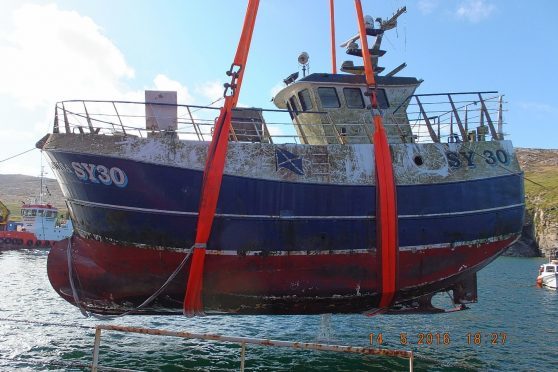The sole survivor of a fishing boat tragedy that claimed the lives of his three crewmates has revealed how he cheated death when the MV Louisa sank off the Hebrides.
Lachlann Armstrong described how he swam for his life, battling in complete darkness through water only a few degrees above freezing towards a shore he could not see.
The 28-year-old said he became exhausted and numbed by the cold, lapsing in and out of consciousness and almost succumbing to the urge to give up and fall asleep.
But he choked on a wave which shocked him awake and he found the strength to struggle onto the shore.
Rescuers found him two and a half hours later, half-naked and unable to stand and clinging to the rocks.
And the father-of-one believes that the life raft’s failure to inflate was the reason his crewmates died, as they instead chose to obey safety training manuals which tell fisherman to stay with the raft to boost survival chances.
Mr Armstrong said: “It was the worst night of my life, our lives.
“We knew we were in trouble. I still can’t believe the other three didn’t survive. I feel so sad, heartbroken. I still find it difficult to accept. I didn’t do anything remarkable, I was lucky.”
Victims Paul Alliston and Chris Morrison, of Lewis, and Martin Johnstone of Caithness, were found by rescuers face down and unresponsive in the water after the tragedy, off the island of Mingulay in April last year.
And last week, marine accident investigators revealed that their lifejackets should have turned over, keeping them clear of the water. It called for urgent research into the testing of the equipment.
The men had been at sea for five days, harvesting crab and lobster and had anchored the 50ft boat about 650ft from the shore.
But, as the marine accident report revealed, a hose used to clean the deck that evening had been left on, and at about 2.30am the crew woke up.
Mr Armstrong explained that, while the ship was going down, they alerted the coastguard, but the emergency vessel failed to inflate as the gas canister to fill it was empty.
The crew started cutting fenders from the railings to stuff in the raft to try and make it float, but it kept falling apart.
And when the boat went under, they jumped on the raft, but the fenders started popping out and they were thrown into the water.
Mr Armstrong said that they had even been “laughing and joking” about the cold before he decided to head back for shore as the others waited.










